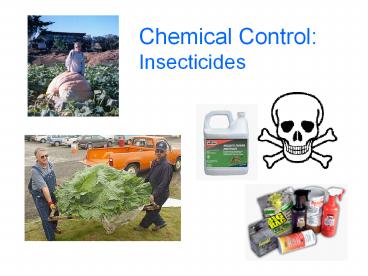Chemical Control: Insecticides - PowerPoint PPT Presentation
1 / 33
Title:
Chemical Control: Insecticides
Description:
Teratogenic, carcinogenic and mutagenic effects. Public concern about Insecticide use ~100% of us have some insecticide residue in our bodies ... – PowerPoint PPT presentation
Number of Views:1686
Avg rating:3.0/5.0
Title: Chemical Control: Insecticides
1
Chemical ControlInsecticides
2
Insecticides are one of the four building blocks
of IPM
IPM
Chemical
Biological
Plant resistance
Cultural
3
Component of pest control since the 1950s
4
Not a perfect solution
- At least 3 million workers poisoned each year
- 20 000 deaths per year
- Teratogenic, carcinogenic and mutagenic effects
5
Public concern about Insecticide use
100 of us have some insecticide residue in our
bodies
6
Insecticides represent an 8 billion industry
7
For the Correct use of insecticides, we need to
consider
Ease of use
Insecticide resistance
Economics
Safety
Insect behavior
Way of delivery
Ecotoxicological impact
Toxicology
8
When to apply?
- Thresholds
- Calendar applications
9
Problems with calendar application approach
- Resistance
- Secondary pests
- Destruction of natural enemies
- Health hazards
- Environmental hazards
10
Going towards better insecticide use
(Dent 2000)
11
Insecticide Composition
Insecticide Active Ingredient Additives
12
Classes of Insecticides
- Botanical Insecticides
- Sabadilla
- Nicotine
- Quassia
- Unsaturated isobutylamides
- Ryanodine
- Naphtoquinones
- Rotenone
- Sweet flag
- Marigolds
- Pyrethrum
- Azadirachtin
- Essential oils
- Botanical insecticides
- Synthetic Insecticides
- Organochlorines
- Organophosphates
- Carbamates
- Pyrethroids
- Neonicotinoids
- Biorational Formulations
- Growth regulators
- Pheromones
- Microbial formulations
13
Botanical Insecticides
- Secondary compounds
- Alkaloids
- Terpenoids
- Phenolics
- Glucosinolates
- Etc.
14
(No Transcript)
15
(No Transcript)
16
Reasons for lack of Commercial Development
- Perceived as old fashioned
- Lack of representation on official lists
- Not as dramatic effects as synthetic insecticides
- Inactivation by exposure to air and light
- Problems due to seasonal availability
- Lack of quantitative information regarding
dosages - Lack of quantitative information regarding
toxicity
17
Synthetic Insecticides
- Synthetic Insecticides
- Organochlorines
- Organophosphates
- Carbamates
- Pyrethroids
- Neonicotinoids
18
- Affect synaptic transmission
19
Concerns
- Some are highly persistent in the environment
- They accumulate in the food chain
- If release from fats, poisoning or death
- Some are banned in developed countries
- Unfortunately, still used in some developing
countries
20
Examples
Carbamates
Organochlorines
- Aldicarb -Carbofuran
- - DDT -
Endosulfan - - Aldrin - Gamma
HCH - - Dieldrin - Gamma
BHC
Pyrethroids
- -Tefluthrin
- - Deltamethrin
- - Lambda
- -cyhalothrin
- - Permethrin
- - Cypermethrin
Organophosphates
-Diazinon -Fenitrothion -Dichlorvos
-Dimethoate - Malathion
- -imidacloprid
- -nitempyram
- - acetamiprid
- - thiamethoxam
Neonicotenoids
21
Biorational Formulations
22
Growth Regulators
- Interfere with development
- Disrupt metamorphosis and reproduction
- Specific for arthropods
23
Hormones involved
- Moulting hormones or ecdysones
- - Re-absorption of old cuticle
- - Deposition, hardening and tanning of new
cuticle - Juvenile hormones
- - Prevent insect from going to next instar.
24
25
Concerns
- Take longer to act than conventional insecticides
- Ecdysones are expensive
- Not ideal when larval stages are the pest
26
Examples
Juvenile Hormones
Chitin Synthesis Inhibitors
- - Methoprene
- - Tebufenozide
- - Fenoxycarb
- - Pyriproxifen
- Diflubenzuron - Hexaflumuron - Triflumuron
Triazine Derivatives
- Melamine - Cryomazine
27
Pheromones
- Mediate intraspecific interactions
- Around 50 available for IPM
- Mostly use in association with traps
28
Pheromones Uses in IPM
- Monitor pest populations
- Mass trapping
- Mating Disruption
- Lure and Kill
29
Microbial Formulations
- Uses bacteria, fungi, nematodes, protozoa and
viruses - Mostly used as inundative releases
- Specific for arthropods
30
Increase interest in Microbial Pest Control
- Resistance to synthetic insecticides
- Decrease in discovery of new synthetic
insecticides and increase of discovery of
microbial novel agents - Increase in the perception of risk posed by
synthetic insecticides - The high host-specificity of microbial pesticides
- Improvements in the production and formulation of
microbial pesticides - Relaxation of the regulations governing
registration of microbial pesticides
31
The Pesticide Treadmill
- Pest resurgence
- Secondary pest outbreaks
- Pesticide resistance
32
Going towards better insecticide use
(Dent 2000)
33
Insecticide Composition
Insecticide Active Ingredient Additives































